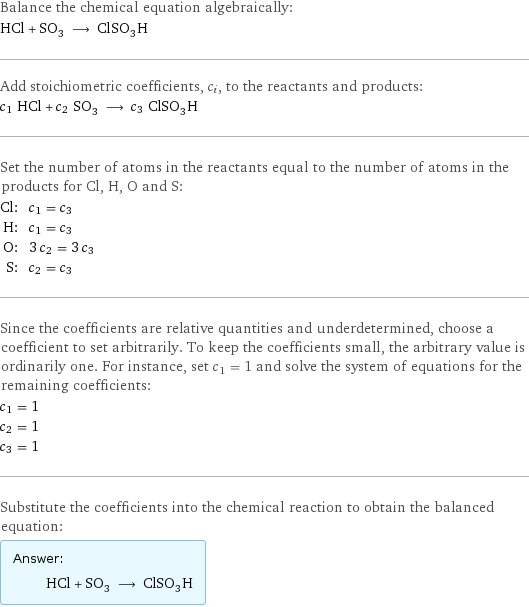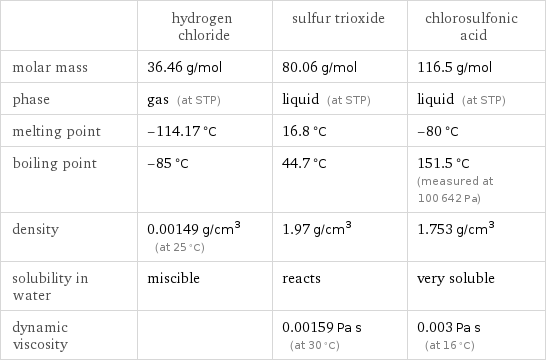Input interpretation

HCl hydrogen chloride + SO_3 sulfur trioxide ⟶ ClSO_3H chlorosulfonic acid
Balanced equation

Balance the chemical equation algebraically: HCl + SO_3 ⟶ ClSO_3H Add stoichiometric coefficients, c_i, to the reactants and products: c_1 HCl + c_2 SO_3 ⟶ c_3 ClSO_3H Set the number of atoms in the reactants equal to the number of atoms in the products for Cl, H, O and S: Cl: | c_1 = c_3 H: | c_1 = c_3 O: | 3 c_2 = 3 c_3 S: | c_2 = c_3 Since the coefficients are relative quantities and underdetermined, choose a coefficient to set arbitrarily. To keep the coefficients small, the arbitrary value is ordinarily one. For instance, set c_1 = 1 and solve the system of equations for the remaining coefficients: c_1 = 1 c_2 = 1 c_3 = 1 Substitute the coefficients into the chemical reaction to obtain the balanced equation: Answer: | | HCl + SO_3 ⟶ ClSO_3H
Structures

+ ⟶
Names

hydrogen chloride + sulfur trioxide ⟶ chlorosulfonic acid
Equilibrium constant
![Construct the equilibrium constant, K, expression for: HCl + SO_3 ⟶ ClSO_3H Plan: • Balance the chemical equation. • Determine the stoichiometric numbers. • Assemble the activity expression for each chemical species. • Use the activity expressions to build the equilibrium constant expression. Write the balanced chemical equation: HCl + SO_3 ⟶ ClSO_3H Assign stoichiometric numbers, ν_i, using the stoichiometric coefficients, c_i, from the balanced chemical equation in the following manner: ν_i = -c_i for reactants and ν_i = c_i for products: chemical species | c_i | ν_i HCl | 1 | -1 SO_3 | 1 | -1 ClSO_3H | 1 | 1 Assemble the activity expressions accounting for the state of matter and ν_i: chemical species | c_i | ν_i | activity expression HCl | 1 | -1 | ([HCl])^(-1) SO_3 | 1 | -1 | ([SO3])^(-1) ClSO_3H | 1 | 1 | [ClSO3H] The equilibrium constant symbol in the concentration basis is: K_c Mulitply the activity expressions to arrive at the K_c expression: Answer: | | K_c = ([HCl])^(-1) ([SO3])^(-1) [ClSO3H] = ([ClSO3H])/([HCl] [SO3])](../image_source/e4703e6450f0d3baf0dfb5cb9bcc539c.png)
Construct the equilibrium constant, K, expression for: HCl + SO_3 ⟶ ClSO_3H Plan: • Balance the chemical equation. • Determine the stoichiometric numbers. • Assemble the activity expression for each chemical species. • Use the activity expressions to build the equilibrium constant expression. Write the balanced chemical equation: HCl + SO_3 ⟶ ClSO_3H Assign stoichiometric numbers, ν_i, using the stoichiometric coefficients, c_i, from the balanced chemical equation in the following manner: ν_i = -c_i for reactants and ν_i = c_i for products: chemical species | c_i | ν_i HCl | 1 | -1 SO_3 | 1 | -1 ClSO_3H | 1 | 1 Assemble the activity expressions accounting for the state of matter and ν_i: chemical species | c_i | ν_i | activity expression HCl | 1 | -1 | ([HCl])^(-1) SO_3 | 1 | -1 | ([SO3])^(-1) ClSO_3H | 1 | 1 | [ClSO3H] The equilibrium constant symbol in the concentration basis is: K_c Mulitply the activity expressions to arrive at the K_c expression: Answer: | | K_c = ([HCl])^(-1) ([SO3])^(-1) [ClSO3H] = ([ClSO3H])/([HCl] [SO3])
Rate of reaction
![Construct the rate of reaction expression for: HCl + SO_3 ⟶ ClSO_3H Plan: • Balance the chemical equation. • Determine the stoichiometric numbers. • Assemble the rate term for each chemical species. • Write the rate of reaction expression. Write the balanced chemical equation: HCl + SO_3 ⟶ ClSO_3H Assign stoichiometric numbers, ν_i, using the stoichiometric coefficients, c_i, from the balanced chemical equation in the following manner: ν_i = -c_i for reactants and ν_i = c_i for products: chemical species | c_i | ν_i HCl | 1 | -1 SO_3 | 1 | -1 ClSO_3H | 1 | 1 The rate term for each chemical species, B_i, is 1/ν_i(Δ[B_i])/(Δt) where [B_i] is the amount concentration and t is time: chemical species | c_i | ν_i | rate term HCl | 1 | -1 | -(Δ[HCl])/(Δt) SO_3 | 1 | -1 | -(Δ[SO3])/(Δt) ClSO_3H | 1 | 1 | (Δ[ClSO3H])/(Δt) (for infinitesimal rate of change, replace Δ with d) Set the rate terms equal to each other to arrive at the rate expression: Answer: | | rate = -(Δ[HCl])/(Δt) = -(Δ[SO3])/(Δt) = (Δ[ClSO3H])/(Δt) (assuming constant volume and no accumulation of intermediates or side products)](../image_source/f7e1155f3a09493d0427ecc2cefd2b6f.png)
Construct the rate of reaction expression for: HCl + SO_3 ⟶ ClSO_3H Plan: • Balance the chemical equation. • Determine the stoichiometric numbers. • Assemble the rate term for each chemical species. • Write the rate of reaction expression. Write the balanced chemical equation: HCl + SO_3 ⟶ ClSO_3H Assign stoichiometric numbers, ν_i, using the stoichiometric coefficients, c_i, from the balanced chemical equation in the following manner: ν_i = -c_i for reactants and ν_i = c_i for products: chemical species | c_i | ν_i HCl | 1 | -1 SO_3 | 1 | -1 ClSO_3H | 1 | 1 The rate term for each chemical species, B_i, is 1/ν_i(Δ[B_i])/(Δt) where [B_i] is the amount concentration and t is time: chemical species | c_i | ν_i | rate term HCl | 1 | -1 | -(Δ[HCl])/(Δt) SO_3 | 1 | -1 | -(Δ[SO3])/(Δt) ClSO_3H | 1 | 1 | (Δ[ClSO3H])/(Δt) (for infinitesimal rate of change, replace Δ with d) Set the rate terms equal to each other to arrive at the rate expression: Answer: | | rate = -(Δ[HCl])/(Δt) = -(Δ[SO3])/(Δt) = (Δ[ClSO3H])/(Δt) (assuming constant volume and no accumulation of intermediates or side products)
Chemical names and formulas

| hydrogen chloride | sulfur trioxide | chlorosulfonic acid formula | HCl | SO_3 | ClSO_3H Hill formula | ClH | O_3S | ClHO_3S name | hydrogen chloride | sulfur trioxide | chlorosulfonic acid IUPAC name | hydrogen chloride | sulfur trioxide | sulfurochloridic acid
Substance properties

| hydrogen chloride | sulfur trioxide | chlorosulfonic acid molar mass | 36.46 g/mol | 80.06 g/mol | 116.5 g/mol phase | gas (at STP) | liquid (at STP) | liquid (at STP) melting point | -114.17 °C | 16.8 °C | -80 °C boiling point | -85 °C | 44.7 °C | 151.5 °C (measured at 100642 Pa) density | 0.00149 g/cm^3 (at 25 °C) | 1.97 g/cm^3 | 1.753 g/cm^3 solubility in water | miscible | reacts | very soluble dynamic viscosity | | 0.00159 Pa s (at 30 °C) | 0.003 Pa s (at 16 °C)
Units
